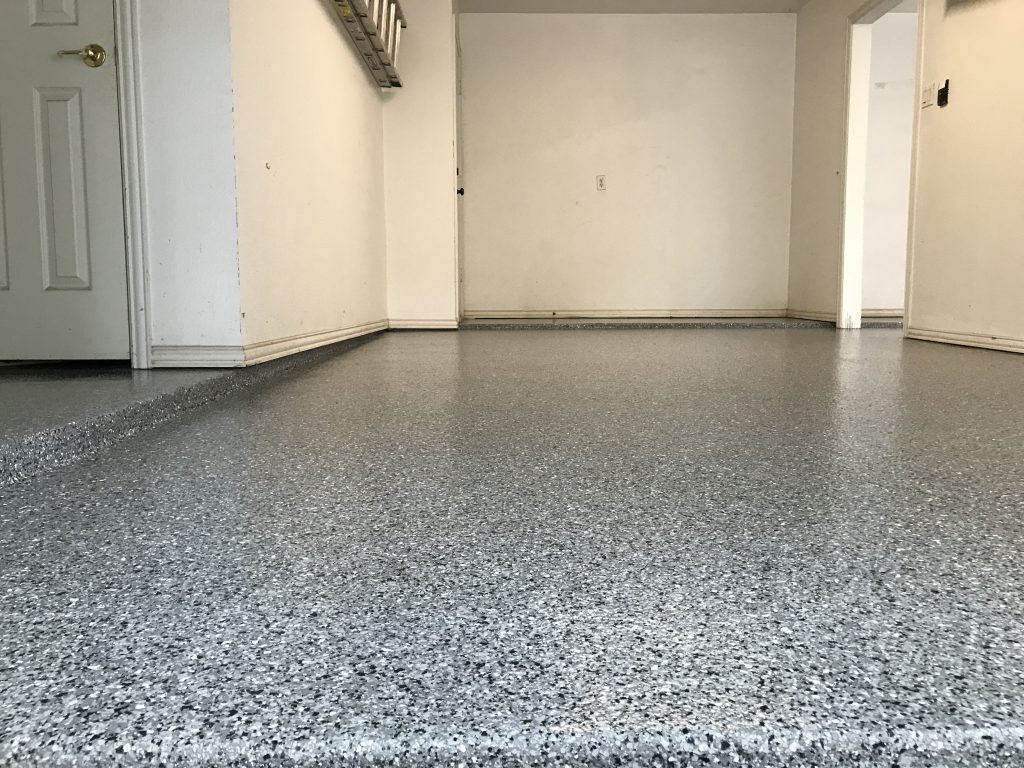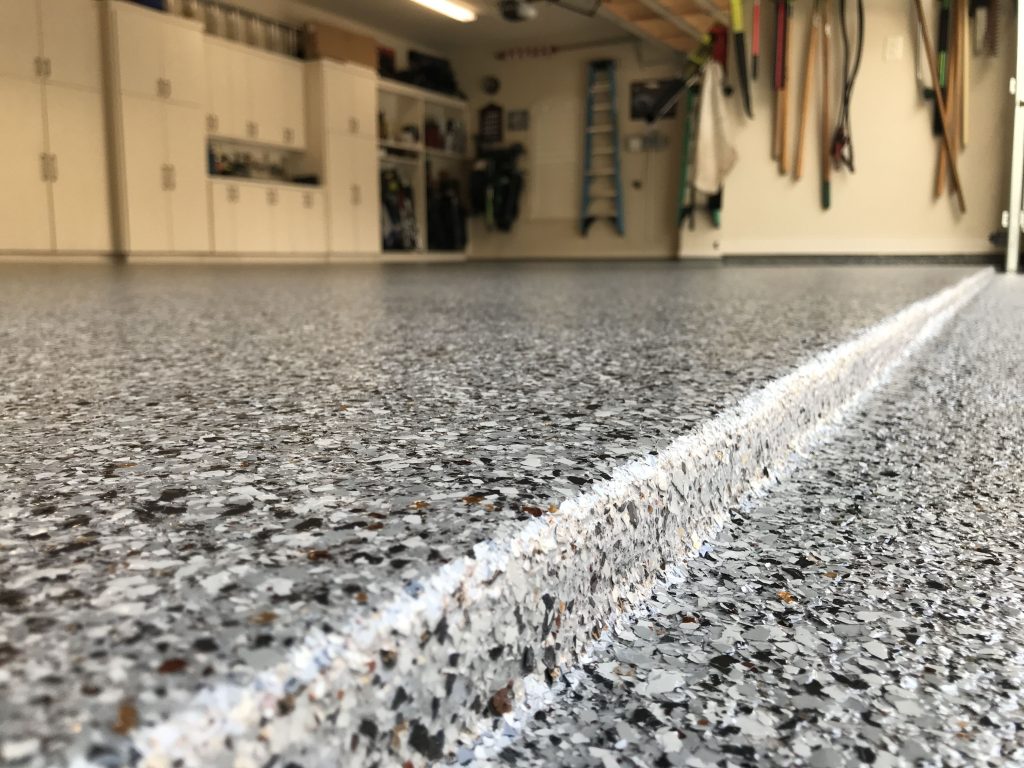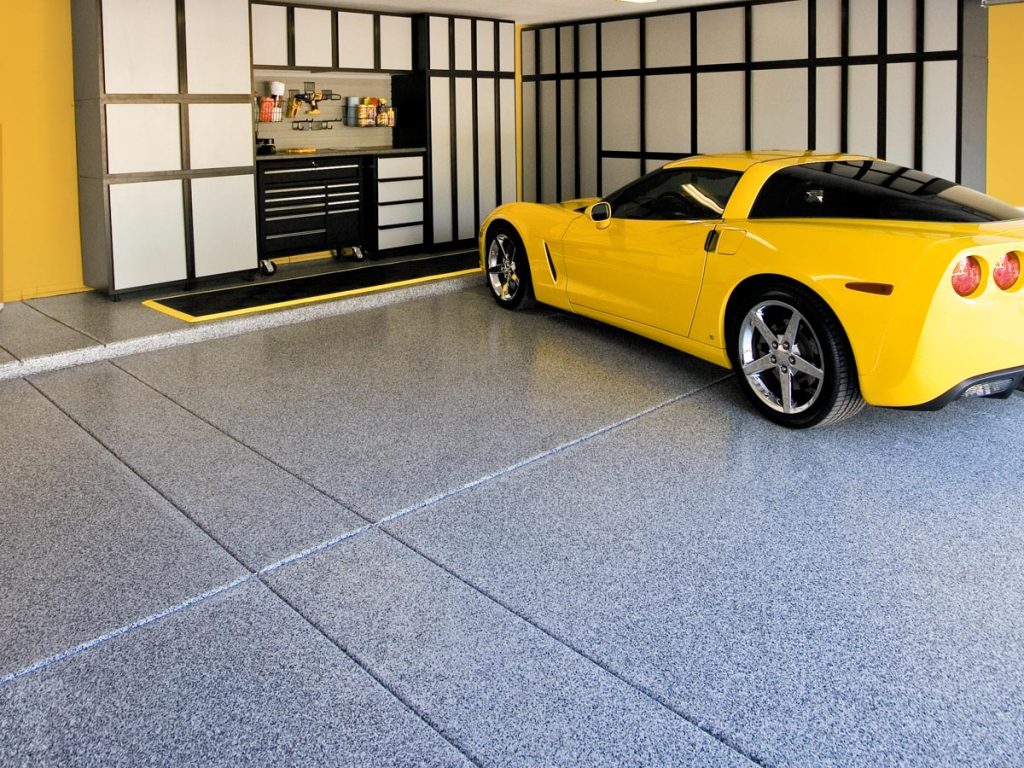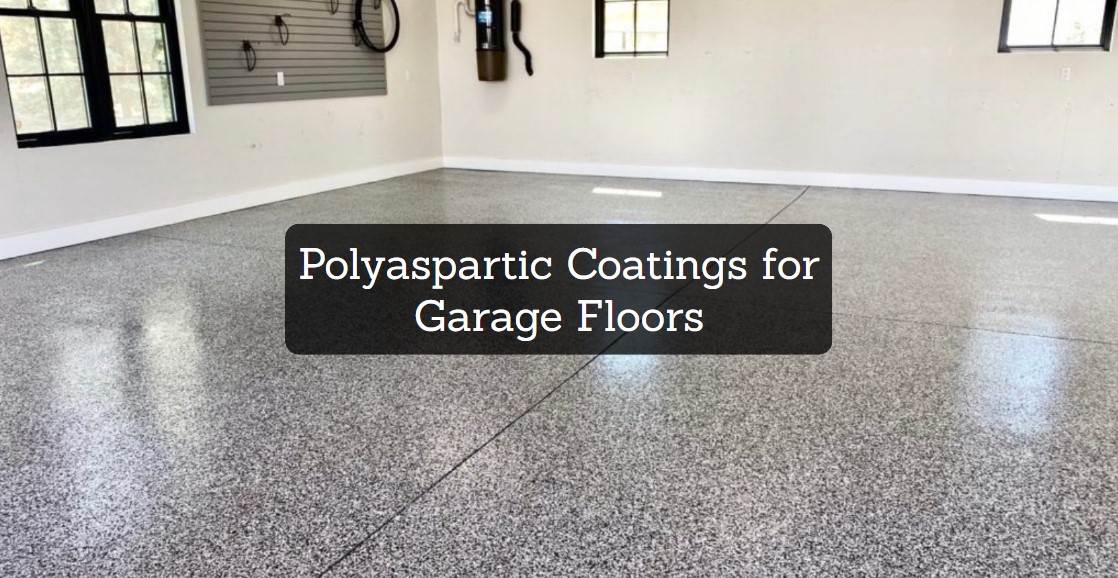In recent years, polyaspartic flooring has emerged as a popular choice for various settings, including garages, commercial areas, and industrial spaces. This type of flooring, known for its aliphatic polyurea composition, was developed in the 1990s and is celebrated for its rapid curing time and robustness, offering protection against chemicals, wear and tear, and UV rays.
And maybe you’d be interested in Garage Concrete Floor Cleaners.

Advantages of Choosing Polyaspartic Flooring
Polyaspartic flooring, a relatively recent advancement in the world of floor coatings, has rapidly gained popularity due to its exceptional qualities and benefits. Here are some of the key advantages of choosing polyaspartic flooring:
- One of the standout features of polyaspartic flooring is its rapid curing time. Unlike traditional epoxy coatings, which can take days to fully cure, polyaspartic coatings can cure in a matter of hours. This quick curing time minimizes downtime for businesses and allows for faster return to service, which is particularly beneficial in commercial and industrial settings where time is often of the essence.
- Polyaspartic flooring is known for its durability. It is resistant to abrasion, chemicals, and UV radiation, making it an ideal choice for areas that experience heavy foot traffic or are exposed to harsh chemicals and environmental conditions. This durability extends the life of the flooring, reducing the need for frequent repairs or replacements.
- This type of flooring offers a wide range of aesthetic options. It can be applied clear or pigmented and can be used to create a variety of finishes, from high gloss to matte. Additionally, decorative chips or quartz can be added to the coating to create a custom look. This flexibility makes polyaspartic flooring suitable for a variety of settings, from industrial to residential.
- Polyaspartic floors are easy to clean and maintain. They are resistant to stains and spills, which can be easily wiped away without leaving any residue. This makes them an excellent choice for areas where cleanliness is a priority, such as healthcare facilities or food preparation areas.
- Unlike some other flooring options, polyaspartic coatings are highly resistant to moisture. This makes them suitable for use in damp environments or areas where the floor may be exposed to water. This moisture resistance helps prevent the growth of mold and mildew, contributing to a healthier indoor environment.
- Polyaspartic flooring can be applied in a range of temperatures, which makes it a versatile option for different climates and seasons. This is particularly beneficial in regions with extreme temperature variations.
- The seamless nature of polyaspartic flooring makes it an ideal choice for environments where hygiene is crucial. The non-porous surface does not harbor bacteria and is easy to sanitize, making it a popular choice in medical facilities, kitchens, and bathrooms.
- Many polyaspartic coatings are formulated to be environmentally friendly, with low VOC (Volatile Organic Compounds) emissions. This makes them a safer choice for indoor environments and reduces the impact on the environment.
You may also like: Best Garage Floor Mats for Winter
Polyaspartic coatings, commonly used for garage floors, have several disadvantages that are important to consider:
- Polyaspartic coatings are typically more expensive than traditional epoxy or other garage floor coatings. This higher cost can be a significant drawback for homeowners on a budget.
- While polyaspartic coatings cure rapidly, which can be an advantage, this also means they require a faster application. The quick cure time leaves little room for error during application, demanding professional expertise for proper installation. Moreover, they are sensitive to temperature and humidity, which can affect the curing process and final result.
- During application, polyaspartic coatings can emit strong odors and VOCs. This can be a concern in enclosed spaces like garages, requiring adequate ventilation and potentially posing health risks during the application process.
- Like other coatings, polyaspartic coatings require thorough surface preparation. Any cracks, chips, or stains on the concrete must be repaired or cleaned before application. This preparation can add to the overall cost and time required for installation.
- Polyaspartic floors can be slippery when wet, which can be a hazard in a garage environment where spills of water, oil, or other liquids can occur. While additives can be mixed into the coating to increase traction, this is an extra step that may be overlooked or inadequately applied.
- Polyaspartic coatings are typically applied in thin layers. While this can be an advantage for certain applications, it may not be ideal for floors that require a thicker coating to address significant imperfections or to provide a more cushioned surface.
- Although polyaspartic coatings are generally UV stable and do not yellow like some other coatings, prolonged exposure to sunlight can still degrade the material over time, leading to potential discoloration and reduced longevity.
- Polyaspartic coatings might not be compatible with all existing floor coatings or treatments. This incompatibility can lead to issues like poor adhesion or chemical reactions that compromise the integrity of the coating.
Polyaspartic flooring, while offering several advantages like durability and low maintenance, comes with its own set of challenges. One of the primary concerns is its higher initial cost. This type of flooring requires a more significant upfront investment compared to other options. However, it’s important to consider that this cost might be offset in the long run due to its long-lasting nature and the reduced need for frequent repairs or replacements.
Another issue is the risk of bubbles forming during the application process. If not applied correctly, polyaspartic flooring can trap air, leading to bubbles or blisters on the surface. This not only affects the appearance but can also compromise the integrity of the flooring. Therefore, proper application techniques are crucial to avoid such defects.
The flooring’s slipperiness when wet, particularly with high-gloss finishes, is another concern. This can pose a safety risk, especially in areas prone to moisture or spills. To counteract this, one can opt for non-slip additives or textured finishes that provide better traction and reduce the likelihood of slips and falls.
High humidity levels can also adversely affect the application of polyaspartic flooring. In environments with significant moisture in the air, the durability and finish of the flooring can be compromised. This sensitivity to humidity necessitates careful consideration of the application environment to ensure optimal results.
Lastly, the rigidity of polyaspartic flooring after it cures can be a drawback. Once set, this type of flooring becomes less flexible, which may impact its ability to absorb impacts. This is in contrast to some more flexible options, like certain epoxy coatings, which might offer better shock absorption. This characteristic of polyaspartic flooring should be considered, especially in areas where the flooring is subject to heavy or frequent impacts.

You may also like: 7 Best Garage Brooms for All Floor Types
When considering polyaspartic flooring, it’s crucial to keep in mind several factors to ensure you make an informed decision:
- This type of flooring needs skilled application to get the best results. Hiring experts is key to achieving an optimal outcome.
- Regular upkeep is essential for preserving both the look and function of polyaspartic flooring. This includes routine cleaning and other maintenance practices.
- Be aware of the Volatile Organic Compound (VOC) levels in polyaspartic products. Understanding these levels is important for environmental reasons and for maintaining good indoor air quality.
- Before deciding on polyaspartic flooring, it’s wise to compare it with other types of coatings like epoxy, urethane, or acrylic. Consider factors such as durability, resistance to wear and tear, the time it takes to cure, and overall costs.
- Look for warranties or guarantees from flooring providers. These can offer protection and peace of mind, covering any unexpected problems that may arise after installation.
You may also like: 11 Garage Floor Paint Ideas (New Types & Colors)
In the realm of garage flooring, polyaspartic coatings stand out for their quick cure times and UV stability. However, the choice between polyaspartic and other coatings like epoxy depends on individual needs and specific scenarios. While more costly upfront, the resilience and durability of polyaspartic coatings can justify the investment. It’s crucial to research, consult professionals, and understand each product’s nuances to make an informed decision.
When choosing the best coating for garage floors, two prominent options are polyaspartic and epoxy coatings, each with its unique attributes and applications.
Epoxy Coatings: Epoxy is a thermosetting resin formed by mixing an epoxide resin with a polyamine hardener. The hardener acts as a catalyst, giving epoxy its strength and durability.
Notably, epoxy coatings are renowned for their robustness and longevity. They create a hard, thick, and impact-resistant surface, ideal for enduring the heavy traffic and mechanical wear typical in garages. Additionally, epoxy is resistant to chemicals like gasoline, motor oil, and antifreeze, making it a practical choice for automotive workspaces.
The application process of epoxy requires precision. The surface needs thorough cleaning and preparation, including degreasing and sometimes etching to ensure the epoxy adheres well.
Temperature and humidity play crucial roles; if not applied under optimal conditions, epoxy can bubble or not set properly. The curing time is significant, usually taking several days, during which the garage will be out of service. However, once cured, an epoxy floor is low maintenance, easy to clean, and aesthetically versatile, available in various colors and finishes, including decorative chips and metallic effects.
Polyaspartic Coatings: Polyaspartic is a type of polyurea, originally developed for coating steel to prevent corrosion. Its use in floor coatings is relatively new but rapidly gaining popularity. Polyaspartic coatings share many of epoxy’s positive attributes—durability, resistance to chemicals, and a wide range of finishes—but also offer additional benefits.
The most significant advantage of polyaspartic coatings is their rapid curing time. Some formulas can cure in just a few hours, drastically reducing downtime. This feature makes polyaspartic coatings ideal for those who cannot afford a long waiting period. Additionally, polyaspartic coatings are more flexible than epoxy, making them more resistant to abrasions and impacts, and less likely to crack over time.
Another advantage is its UV stability. Unlike epoxy, which can yellow or fade when exposed to sunlight, polyaspartic coatings retain their color and gloss over time, even in sunlit areas. This characteristic is particularly beneficial for garages with windows or doors that let in natural light.
However, polyaspartic coatings have their challenges. They require a more skilled application, as the fast curing time leaves a short window for application, making it less forgiving than epoxy. Also, the material and labor costs for polyaspartic coatings are typically higher than for epoxy, making it a more expensive option overall.
You may also like: 8 Best Garage Floor Drain Systems to Buy
Comparison and Decision Making: When deciding between epoxy and polyaspartic coatings for a garage floor, several factors should be considered:
- Both options are highly durable, but epoxy’s thickness makes it slightly more resistant to heavy machinery and high traffic, while polyaspartic’s flexibility makes it more resistant to impacts and less prone to cracking.
- Epoxy requires a longer curing time, which could be a disadvantage if the garage needs to be operational quickly. Polyaspartic coatings, with their rapid curing, offer a practical solution for time-sensitive projects.
- Both coatings offer a range of finishes, but if UV stability is a concern, polyaspartic is the clear winner as it does not yellow over time.
- Generally, epoxy is more cost-effective than polyaspartic, both in terms of material and labor costs. However, the long-term benefits of each should be weighed against the initial investment.
- The application environment is crucial. Epoxy is sensitive to temperature and humidity during application, whereas polyaspartic is more tolerant of varying conditions.
- Both coatings are easy to maintain and clean, but epoxy might be more prone to scratches and require reapplication over time.
In conclusion, the choice between polyaspartic and epoxy coatings for a garage floor depends on individual needs and circumstances. For those prioritizing cost-effectiveness and working with heavy machinery, epoxy might be the better choice.
On the other hand, for projects requiring quick turnaround, UV stability, and flexibility, polyaspartic coatings offer distinct advantages. Ultimately, both options provide durable, attractive, and practical solutions for garage flooring.


